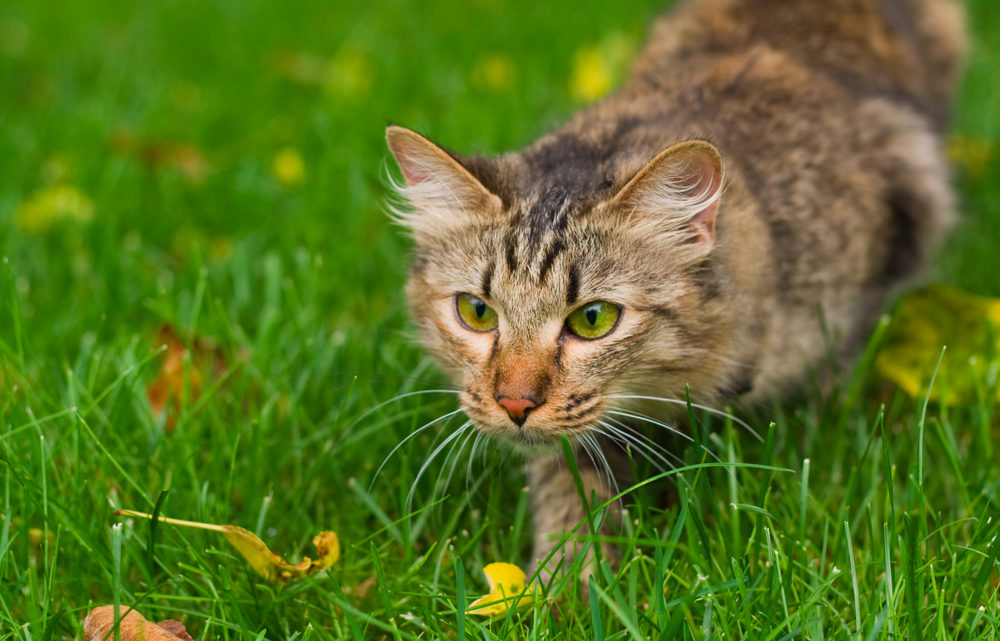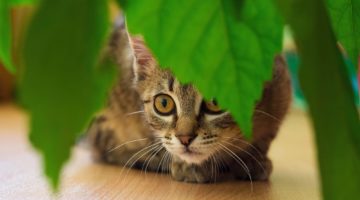As an obligate carnivore, your cat is a hunter at heart. Research that explores the intersection between their hunting and eating habits is changing how we feed our kitties – and has a positive impact on feline health and behavior.
Like most domestic animals, your kitty probably eats from a bowl or dish at set times of the day. But if you’ve ever witnessed your cat’s hunting instincts, you’ll know that the way felines feed in the wild is very different from how we feed them in our homes. Research into feline behavior is changing our understanding of the link between our cats’ hunting and feeding needs, and how catering to your cat as a hunter can improve his health and well-being.
Cats in the wild
Living on their own in the wild, free-ranging cats are solitary hunters that stalk and catch small prey, says Elizabeth Waring, a feline behaviorist with International Cat Care in the United Kingdom.
In order to meet their daily energy and nutritional requirements, these cats need to kill and eat an average of ten prey animals each day. This means they consume small, frequent meals and spend most of their waking hours seeking and hunting for food.
Additionally, because feline prey is more active at dawn and dusk, that’s when cats are most actively hunting. “It’s therefore easy to see how a cat’s feeding behavior might be in conflict with an owner’s routine,” Elizabeth says.
Indoor cats don’t get to hunt
In most human households, pet cats are fed a couple of times a day (unless dry food is left out in a bowl all day) at the convenience of their people. “This means cats no longer follow their natural patterns of eating little and often, day and night,” Elizabeth says.
The majority of cat owners also keep their kitties indoors, leading boring lives where they walk from the couch to the food bowl and back to the couch. This doesn’t even approximate what they do in the wild.
Boredom leads to health and behavioral problems
This disconnect can result in health and behavioral problems. Boredom can lead to inactivity, which can lead to overeating and obesity, which can then lead to metabolic diseases such as diabetes, and behavioral issues such as urinating or defecating outside the litter box, bolting food then vomiting, waking people at night, and even aggression.
“How you feed your cat is as every bit important as what you feed him,” says veterinarian Dr. Elizabeth Bales, creator of the Indoor Hunting Feeder, a set of mouse-shaped feeders that cats “hunt”. People love their cats and give them the best of everything, she notes — but it’s the best of everything from a human perspective, not a feline one.
In nature, Dr. Bales explains, a cat’s whole purpose is to hunt and find prey. “When you take that purpose away, and just give him a bowl of food, it shifts everything for him.”
She adds that cats, unlike dogs, are not genetically built to express their needs. When their innate needs are not being met, they become stressed and exhibit that stress by peeing outside the box, becoming food obsessed, and being destructive or aggressive. Worse, cats can “emotionally shut down” and simply sleep all the time.
Engaging cats in hunting behavior
Being able to engage in hunting behavior to eat, Dr. Bales says, changes all that. Cats are less anxious and more relaxed, so they’re not urinating or defecating outside the litter box or being aggressive with people or other cats. They stop waking people in the middle of the night to be fed, and “scarf and barf” behavior disappears.
The research that has been done exploring the intersection of cat behavior and nutrition reveals ways to feed cats that are better suited to their natural feeding patterns (see below).
As research into feline feeding needs moves beyond the veterinary research community and into the mainstream, Dr Bale thinks feeding cats once or twice a day from the same bowl in the same place will become less and less the norm. More people will be seeking to improve their cats’ health and behavior by giving them ways to “hunt” for their food.
Feline feeding tips
- Feline behaviorist Elizabeth Waring recommends dividing a cat’s daily food intake into small meals, with a minimum of five portions. You can hide these portions throughout the home at different times of the day, so your cat has to “hunt” for them. It’s a good idea to change the locations of the food; in nature, cats wouldn’t find their prey in the same spot all the time.
- If hiding portions of food isn’t an option, or you’re not available to feed your cat at least small five meals a day, timed automatic feeders can be a solution. While they don’t address feline hunting needs, they can be programmed to dispense smaller, multiple meals a day, which is still an approximation of how cats have naturally evolved to feed.







No Comment